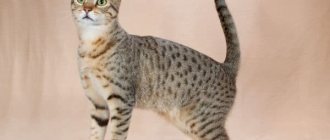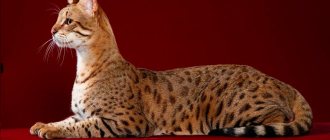Thai cats are all the rage these days and people love their sophisticated, elegant look. These are small, well-proportioned pets that are often confused with Siamese cats due to their color. Thai cats for the most part have a white fur coat, and the face, limbs, tail and ears are colored in shades harmonizing with white. These animals simply amaze with their beauty! In the article we will look at photos and names of colors of Thai cats. We will see classic, fashionable and the rarest variations of “fur coats”.
Features of color
The Thai breed is distinguished by its nobility and dignity. One has only to look into their bright blue eyes, and you immediately understand that nature is a true artist who creates real masterpieces. Non-professionals often confuse the Thai cat with the Siamese, but the difference is colossal, even despite the relationship (the Thai is a descendant of the Siamese). Their color is also called acromelanistic (acromelanism - coloring of protruding parts of the body in contrasting tones), Himalayan and point. So, if you hear such names, you will immediately know which one they are talking about.
As for the main specificity of the color of the Thai cat, it is the ability to change, as if blooming. Kittens of this breed are born completely white, but over time the protruding areas (ears, muzzle, tail, paws) begin to acquire darker colors. But the darkening process does not end as the animal grows, it continues throughout its life! If the cat is a show cat, then clear contrast is important - the darker and more uniform the points, the greater the chances of success. Over time, Thai beauty may darken completely, and this is completely normal!
As for the incredible blue eyes of Thais, this is their “trick”. Animals have these eyes from birth, and there simply cannot be any other color.
The colors of Thai cats are varied; there are many shades and types. It is about them that we will talk further.
Description of Thai cats
Thai cats are similar to well-fed Siamese cats - round faces, shorter legs, lack of angularity. The appearance of modern Thais completely coincides with the original old-type appearance of the breed. This is what the exterior description looks like:
- The body is medium in size, compact and stocky. The weight of Thai cats ranges from 3 to 5 kilograms;
- The head is round, resembling an apple. The muzzle is slightly extended forward;
- The eyes are slanted, blue, in the form of large almonds - a distinctive feature of purebred Thais;
- The ears are smaller than those of the Siamese and are located on the sides. The tips are rounded;
- The neck is strong and muscular, of medium or short length;
- Tail proportional to the body with a round tip;
- Slender but powerful legs with small round paws;
- The coat is short and dense, without undercoat. Less attached to the body than Siamese cats, which is why Thais appear larger.
Many people confuse Siamese cats with Thai cats, but the differences between these breeds are noticeable to the naked eye. In general, Thai cats appear rounder and fluffier.
Seal Point
The color of the Thai seal point cat is standard, classic and is very common. The main color of a cat's coat is light cream, which softly fades into a light shade of brown. The points are often dark brown and sometimes almost black in color, the markings are contrasting, so this color of the Thai cat is often found at exhibitions.
As already mentioned, the eyes should have a sky blue color, and if a green iris is noticeable on them, then this is a huge minus, as is the presence of light hairs on the paws.
Advantages and disadvantages
Like any breed, Thais have their own pros and cons. The advantages of these cats include:
- sociability;
- excellent communication skills with people and other animals;
- devotion;
- friendliness and lack of aggression;
- developed mind;
- good manners and ability to train.
But there are several disadvantages. These include an increased sense of revenge - a Thai cat will not tolerate bad treatment at all. These animals can also be called overly stubborn. If a kitten wants something, he will make every effort to achieve it.
Blue Point
Like the previous type of color, this one is classic, and they are very similar to each other. In this variation, the color of the Thai cat is basically white with a bluish color. Most often the tone is cold, but there may also be a slight warm undertone. Here it is important to pay attention to the ears: under no circumstances should they stand out in a darker tone than the other color markings.
The sole and pads, like the cat's nose, are often slate-colored. The eyes, like those of other species, are blue, but there are also secrets here. Experts say that the eye color should not be pale in this color variation, since in contrast with the gray-blue markings they will look faded, and this fact will not serve as an advantage at exhibitions.
Health of Thai cats
Since the history of the breed began several centuries ago, over the years Thai cats have developed good health and immunity. With such a cat you will not have to visit the veterinary clinic often. If there are no changes in the pet’s well-being, it is recommended to bring the cat for a preventive examination 1-2 times a year.
Despite good genetics, Thais are prone to the following diseases:
- Diabetes;
- Tumor of the mammary glands and lungs;
- Heart diseases: congenital and acquired defects;
- Hydrocephalus is watery fluid on the brain.
Thai cats are long-lived and often live up to 25 or even 30 years.
Average life expectancy is 10-15 years. Did you like the article? Share with your friends!
Chocolate point
This name of the Thai cat speaks for itself. But let’s describe it in more detail.
The base has a noble ivory color. The markings are the color of milk chocolate and practically do not change over the years. The combination of these colors looks very impressive. Against the background of ivory and brown, expressive points, the animal’s blue eyes look no less impressive. They can have a pure color or with a violet-colored iris.
The color of the Thai chocolate point cat breed received universal recognition not so long ago - in 1950.
frost point
Otherwise, the color is called lilac point and was recognized by experts even later than the previous one - in 1954.
The base of the coat is white, but it is set off by warm ivory. The beauty is in the markings, which decorate the cat with a lilac-pink color with a gray tint. The markings do not stand out too much, they seem pale, but still this is one of the leading colors.
The eyes are blue, the iris may be even lighter. They are lighter than other representatives of the breed, but not pale. The cat has a cool color, and the points practically do not darken throughout its life.
There are even younger varieties of colors of Thai cats, photos of some are presented in the article. The new shades are inspired by fashion trends, we invite you to consider them in more detail.
Personality of Thai cats
| Activity |
| Playfulness |
| Sociability |
| Affectionateness |
| Friendliness |
| Intelligence |
In their disposition, such cats are reminiscent of dogs: Thais are easy to train, they love to bring a ball to their owner and follow on his heels. These pets will wait for you at the door every day when you get home from work, greet you joyfully and purr. Thai cats are very loyal to their owner, so they are uncomfortable being alone.
They are curious and playful. These are not the cats that prefer to sleep all day and do nothing. Thais love to explore familiar and new territories, jumping and doing acrobatics. It is important to properly direct the energy of such a pet so that it does not get bored.
Thai cats will surprise and make their owner laugh every day. They are childishly spontaneous and restless. These are real actors, so they will easily become the center of attention of all family members.
Compatible with children and other pets
This breed has a lot in common with children, so Thai cats easily become children's favorites. Thais are delicate and do not extend their claws when playing. They will not bite a child, even if he behaves incorrectly with the cat. Some representatives of the breed even become a nanny for the child.
Thai cats get along well with other cats and dogs, as they do not tolerate jealousy and fighting. However, they prefer human company. Because of this, other pets may be jealous of the owner of the Thai - take into account the character of the other tailed family members.
Cream point
Amazingly beautiful color! The fur is white, diluted with a warm creamy tint. Point markings have a darker, contrasting cream color. The points may also have marks - small stripes. Experts do not consider them a disadvantage, but it will still be better without their presence.
The paw pads and nose are pink. Another noteworthy nuance is the presence of freckles on the lips, soles and eyelids in the form of a scattering of small brown spots. Freckles are an optional but attractive part of the color.
Red point
One of the most interesting animal color options. The cat's coat is white, but a slight tint of apricot gives it a warm tint. The points are not even red, but red and gold in color, which stand out with bright spots. It is possible, but not desirable, to have small stripes on the marks.
The pads and nose are soft and pink. On them, as on the eyelids and lips, the presence of small freckles is welcome.
Blue eyes look especially bright against the background of this color! An incredibly beautiful combination, for which many people choose such cats (despite the fact that they are not the rarest).
Torty point
Only representatives of the female half of the Thai breed can boast of such a beautiful variegated coat color. For many people, this coloring came as a surprise, since it is almost impossible to recognize on kittens. From a white lump, as it grows up, a beautiful white cat grows with soft peach markings, on which there are speckles interspersed in all shades of black and red. In kittens, these inclusions are small or absent altogether, but appear later.
If you want a unique animal, then take a closer look at the torty point, because it is simply unrealistic to meet a twin by color. Each cat has a unique pattern on its points; it can even change as the animal grows older.
How to choose a kitten
The best time to take a kitten home is at least 2 months old. Exhibition animals are sold after 5-6 months, when the teeth have completely changed. And the best age when you can evaluate the baby’s exterior and exhibition future is 4 months.
The main criteria for choosing a kitten are simple: it must be healthy, be able to go to the toilet on its own, and preferably use a scratching post.
Gender doesn't matter. An uncastrated cat will mark where he likes, and an unsterilized cat will meow loudly and demand love. And such characteristics of the breed as cunning, cunning, and stubbornness are characteristic of both boys and girls. The only cats are more affectionate and careful than cats.
Each Thai breeder has his own price for a kitten. The determining factor of how much a purebred Thai kitten costs is class. For show class pets the highest price is from 25 thousand rubles, breed class – 10 thousand rubles, pet class can be purchased from 5 thousand rubles.
Links Point
We call this color of a Thai cat differently - tabby point. Links Point is a common name in America. What is the difference from other Thai cats? It's all about the points - they are not just darkening in the form of spots, but spots formed from clearly defined stripes. The name of the color indicates the color of the points, and they are as follows:
- if the stripes are black - seal tabby point;
- red - orange tabby point;
- bluish-gray – blue tabby point;
- milk chocolate color - chocolate tabby point.
The color of the Thai tabby point cat is distinguished by a distinct mark on the forehead in the form of the letter “M” - an interesting manifestation of the stripes. The fur of the same color is the rest of the points, the nose stands out especially clearly. There are freckle spots on the face in the cheek area.
The stripes on the tail and front legs of the animal are formed into a pattern of torn rings, which originate from the toes and go higher. The cat's hind limbs are of a uniform color, and there are clearly defined stripes on the hips.
The ears are single-colored, with small (about the size of a thumbprint) spots appearing on the outer side that are lighter. The inside color of the ears is lighter than the other points.
Experts say that a brighter contrast of the main color and points is preferable. If this is not the case, then at exhibitions it may be considered a disadvantage.
The nose is pink, but along the edge there should be a border matching the color of the points. Paw pads are pink.
Caring for Thai cats
Thai cats are a fairly clean breed, so they won’t cause you much trouble keeping them. To care for the fur, you need to purchase a special brush. Brushing your cat once every couple of weeks is enough. Thais do not like to bathe, so only take them into the bathroom if absolutely necessary: when they are very dirty or to prepare for an exhibition.
Feeding these cats is not particularly difficult. Choose high-quality ready-made food or create a menu of natural food if you have time to cook for your cat. However, it is undesirable to give some foods to a Thai cat, as they cause darkening of the fur. These include liver, seafood, algae and iodine.
History of Tabby Point Breeding
This is one of the youngest colors, but it quickly gained popularity around the world. The appearance of the tabby point in Russia coincided with the development of another remarkable breed - the Neva masquerade cat.
In England, Thai breeding had been going on for a very long time, and by the mid-twentieth century, many of the famous colors were already known. The tabby point was born quite by accident.
In the nineties, work on breeding Thai and Siberian cats was carried out in a nursery in St. Petersburg. As it happened, there was an unplanned mating of different breeds of animals, and as a result, the most interesting kittens were born - some became the beginning of the Neva Masquerade breed, others became the first Thai cats with tabby color.
How to name a kitten
The character of Thai cats and the history of the breed provide the owner with many options for choosing a name for his pet.
You can choose from Thai names that are pronounced with the emphasis on the last syllable:
| Nickname for a boy kitten | Nickname for a girl's kitten |
| Aron, Vaen, Det, Kosum, Kitty Krysi, Chris, Mai, Manoj, Nai, Nok, Phen, Khan, Mongkut, Narong, Niran, Thaksin, Lek, Dao, Nok, Kai, Samon, Kosum, Apple, Yu | Agum, Dara, Dao, Spark, Kama, Mali, Bunsi, Buppa, Mali, Vaen, Nari, Num |
These nicknames are just hints. They say that all you have to do is look into the sky-blue eyes of a kitten, and he will come up with an idea.
Rare colors
We looked at many varieties of “fur coats” of Thai cats, but we left the rarest and most expensive ones for last. Experts have identified the following variations:
- Cinnamon Point. This is a handsome guy with white fur without shades. The points are a cinnamon color, and the contrast of warm and cold looks very impressive.
- Caramel point. The fur is white, with a tint reminiscent of magnolia flowers. Caramel points (brown-gray). Stripes on marks are not welcome, but they do happen.
- Fawn point is a magical color! The base is like white magnolia, but shaded with soft tones of beige or pink-lilac. The points are also unique - pastel pink.
- Gray-brown point. This color is stunning in its contrast. The base is a pure white coat, without any shades, with clear markings of brownish-gray color, with a pink or purple tint.
Unrecognized colors
In Holland and England, breeders are working hard to create the Apricot Point and Silver Point colors. These species are not yet recognized, as they appear as a result of a spontaneous, but still unclear mutation.
Experts believe that there is no point in recognizing new colors, since they are very similar to existing ones, and a layman cannot determine the line between them (and not all professionals recognize the differences).
Disadvantages in color
Often Thai cats have a “marriage”, which is simply impossible to determine in kittens (due to the absence or pallor of markings). Any spots on the tummy are considered deficiencies in color; it should be uniform, whitish hairs on points, white spots on points, pallor in eye color.
As for exhibitions, you can most often find tabbies there, rarely seal point (non-professional breeders prefer them). The greatest rarity is to meet a red point or tortie point at an exhibition.
We have reviewed the colors of Thai cats, the descriptions of which will help you imagine what the animal will be like as an adult when you choose another kitten! But this information will help if the points have already begun to appear.











